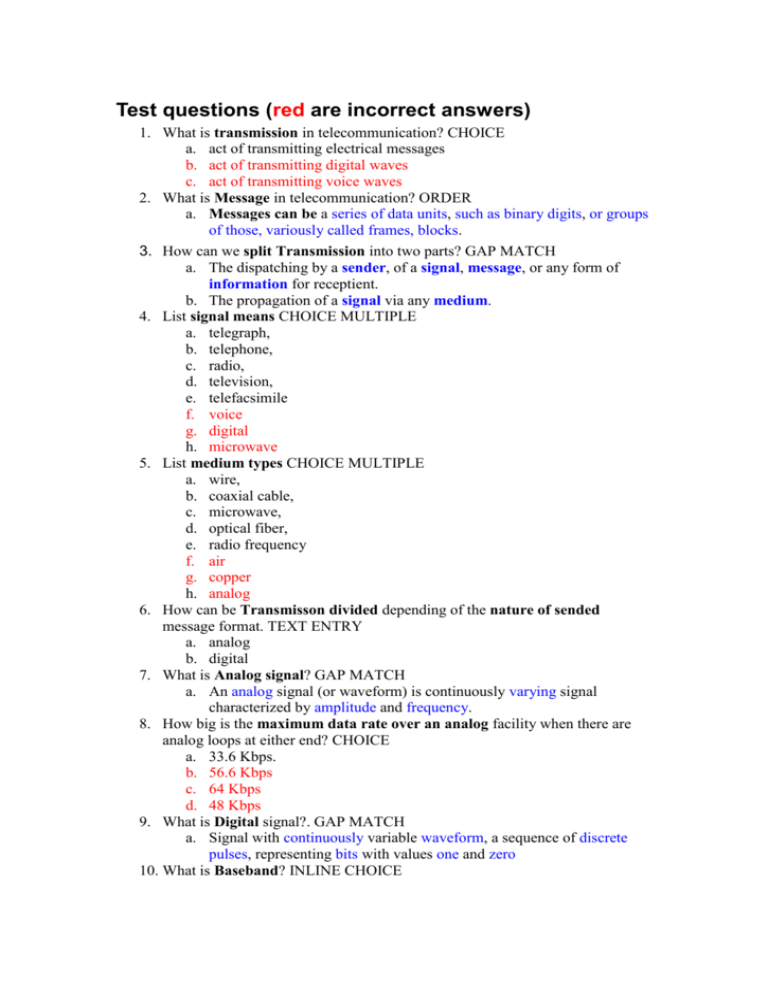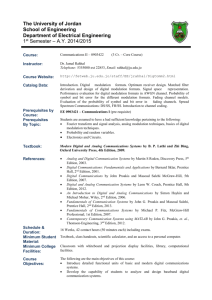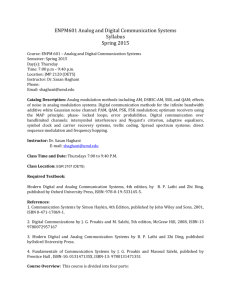Test questions (red are incorrect answers)
advertisement

Test questions (red are incorrect answers) 1. What is transmission in telecommunication? CHOICE a. act of transmitting electrical messages b. act of transmitting digital waves c. act of transmitting voice waves 2. What is Message in telecommunication? ORDER a. Messages can be a series of data units, such as binary digits, or groups of those, variously called frames, blocks. 3. How can we split Transmission into two parts? GAP MATCH a. The dispatching by a sender, of a signal, message, or any form of information for receptient. b. The propagation of a signal via any medium. 4. List signal means CHOICE MULTIPLE a. telegraph, b. telephone, c. radio, d. television, e. telefacsimile f. voice g. digital h. microwave 5. List medium types CHOICE MULTIPLE a. wire, b. coaxial cable, c. microwave, d. optical fiber, e. radio frequency f. air g. copper h. analog 6. How can be Transmisson divided depending of the nature of sended message format. TEXT ENTRY a. analog b. digital 7. What is Analog signal? GAP MATCH a. An analog signal (or waveform) is continuously varying signal characterized by amplitude and frequency. 8. How big is the maximum data rate over an analog facility when there are analog loops at either end? CHOICE a. 33.6 Kbps. b. 56.6 Kbps c. 64 Kbps d. 48 Kbps 9. What is Digital signal?. GAP MATCH a. Signal with continuously variable waveform, a sequence of discrete pulses, representing bits with values one and zero 10. What is Baseband? INLINE CHOICE a. Baseband is an adjective that describes signals and systems whose range of frequencies is measured from 0 to a maximum bandwidth or highest signal frequency; it is sometimes used as a noun for a band of frequencies starting at 0. 11. What is line coding? GAP MATCH a. line coding or Baseband modulation aims at transferring a digital bit stream over an analog baseband channel. 12. Why is necessary to convert between two signal types? HOTTEXT a. Today we don't have pure digital or pure analog networks; we have a mix of them, Collection of them Therefore, at various points in a network, is necessary to convert, to reduce to transfer between these two signal types. 13. Name conversion devices HOTTEXT a. The devices that can handle conversions are called codecs, multiplexers, transformers and modems, transformers, stations. 14. Why we need codec in cellular networks? INLINE CHOICE a. In cellular networks, because of the constraints and available spectrum, a codec needs to compress, modulate, amplify the voice further to get the most efficient use of the spectrum, channel, bandwith transmission 15. What is the basis of term codec? CHOICE a. contraction of coder-decoder b. Core digital encryption c. Cooperative decryption 16. What is the basis of term modem? CHOICE a. contraction of modulate-demodulate b. modern modulation c. mode of demodulation d. more decrypted modulation 17. Why we need modems? INLINE CHOICE a. Modems used to infuse digital data, encrypted data ,electrical data ,more data onto transmission facilities, process, bandwith and vice versa 18. Name digital modems CHOICE MULTIPLE a. ISDN, b. ADSL c. Smart modem d. Legacy modem e. V32bis f. V.everything 19. How we can transmit digital signals over analog network? INLINE CHOICE a. We need modem, repeater, coder, quantizer between digital source and analog multiplexer, repeater, coder, quantizer 20. What is sampling? INLINE CHOICE a. sampling is the reduction of a continuous, coded, encrypted, discrete signal to a discrete, coded, encrypted, discrete, continuous signal 21. What is source coder? INLINE CHOICE a. source coder is a device that maps an analog, coded, encrypted, discrete input into a digital, coded, encryped, continuous output. 22. Name the basic constituents of pulse code modulator (PCM) ORDER a. sampler, quantizer, symbol-to-bit mapper 23. What is the aim of digital modulation? INLINE CHOICE a. The aim of digital modulation is to transfer a digital bit stream, coded signal, encrypted signal over an analog bandpass, copper wire, optical fiber, digital baseband channel 24. What is the aim of analog modulation? INLINE CHOICE a. The aim of analog modulation is to transfer an analog lowpass, coded, encrypted, discrete signal over an analog bandpass, copper wire, optical fiber, digital baseband channel 25. What is the aim of pulse modulation methods? INLINE CHOICE a. The aim of pulse modulation methods is to transfer a narrowband analog, coded, baseband, digital signal over a wideband lowpass, encrypted, narrowbaband, discrete channel or, in some of the schemes, as a bit stream, character stream, bait stream over another digital, widebaband, analog, point-to-point transmission system. 26. Common analog modulation techniques groups are: CHOICE MULTIPLE a. Angular b. Amplitude modulations c. Quadrature-phase d. Phase-separated e. Frequency-devided 27. Most fundamental digital modulation techniques are (choose 4): CHOICE MULTIPLE a. Phase-shift modulation, b. frequency-shift modulation, c. amplitude-shift keying d. quadrature amplitude modulation e. basefrequency modulation f. orthogonalangular modulation g. singular modulation 28. What is communications channel? INLINE CHOICE a. Channel, in communications (sometimes called communications channel), refers to the medium, state, object used to convey information, voice, microwave, frames from a sender (transmitter) to a receiver. 29. What is quantization? INLINE CHOICE a. quantization is the process of approximating, rotating, conveying, transferring a continuous range of values, bits, baits, signals (or a very large set of possible discrete values, continuous values, functions, data) by a relatively-small set of discrete symbols, functions, bits or integer, current, single, floating-point values 30. Name the Types of Network Connections CHOICE MULTIPLE a. Switched, b. Leased-line c. Dedicated d. Separated e. Parallel f. domain 31. What is multiplexing? INLINE CHOICE a. multiplexing (short muxing) is a process where multiple, two, hundred, one analog message signals or digital data streams, information, code are combined into one, tremendous, baseband, lowpass signal. 32. What is the aim of multiplexing? INLINE CHOICE a. The aim is to share an expensive resource, experience, computer, signal. 33. Name the Transmission Modes CHOICE MULTIPLE a. Asynchronous b. Synchronous c. Splitted d. Amplified e. Modulated 34. Describe Single-sideband modulation INLINE CHOICE a. Single-sideband modulation (SSB) is a refinement of amplitude modulation, frequency modulation, analog modulation, angle modulation that more efficiently uses electrical power, computers power, resources, bandwith and bandwidth, modem, router. 35. What is main feature of Frequency-division multiplexing (FDM) INLINE CHOICE a. With FDM, the entire frequency band, electromagnetic spectrum, radio frequency band available on the communications link is divided into smaller individual bands, data rates, time slots, wavelenghts or channels, bands, bitstreams 36. What is main feature of Time-division multiplexing (TDM) INLINE CHOICE a. Each device in a predetermined, random, ordered, separated sequence is allotted a time slot, channel, bandwidth, wavelength during which it can transmit 37. What is main feature of Statistical time division multiplexing (STDM) INLINE CHOICE a. Statistical time division multiplexers dynamically, statistically, randomly, indenpendently allocate the time slots, channel, bandwidth, wavelength among the active terminals, which means you can actually have more terminals than you have time slots, channel, bandwidth, wavelength 38. What is main feature of Wavelength-division multiplexing (WDM) INLINE CHOICE a. Wavelength-division multiplexing (WDM, DWDM, CWDM) is based on the concept of using multiple wavelengths, channels, time slots, physical layers of light, sound, microwave, infrared on a single fibre, wire, channel, band





